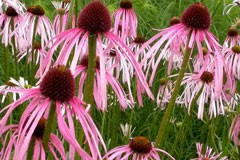- Out-of-Stock



Close relative of Echinacea angustifolia, also used in herbal medicine, sharing many similarities. I find it a better garden plant, more vigorous and productive in growth, and manages better in winter wet.
Close relative of Echinacea angustifolia, also used in herbal medicine, sharing many similarities. I find it a better garden plant, more vigorous and productive in growth, and manages better in winter wet.
Data sheet
Tall perennial suitable for clay soil types, winter deciduous and frost resistant. Light blue flowers in summer on tall stems, clumping and easy.
Mound forming succulent for sunny dry areas, pots or rock garden; best if kept dry. Attractive leaves in rosettes.
Slender upright green, lemon and cream coloured poker , flowers fading to a softer colour as they age. Superb cut flower & accent plant amongst grasses and perennials.
Old fashioned cottage garden perennial, robust form with upright flower stems, rich cobalt blue.
Attractive multicoloured variety, which starts off as lime green and cream then ages to pink or pale blue depending on soil pH. Morning sun only, best in part shade with good drainage.
Late summer filler for perennial border, flowering from summer into winter. An easy plant that will in fill nicely between penstemons, euphorbias and dahlias. Dead head to prolong flowering, purple flowers on tall airy stems.
Robust and moisture tolerant species from Nepal, with attractive tall foliage and lime-green flowers. A stately elegant plant that can be cut to the ground in winter, flowers appear early summer alongside delphiniums, lupins, and campanula.
Mashua. Grown in the Andes for its edible tubers which are best roasted like potatoes or yams. A climbing, shade loving plant which needs a cool site and good drainage.
A clumping Campanula persicifolia with full pure white double flowers. Lovely in between roses with Geranium 'Rozanne'. Easy to manage and non-invasive.
Tall semi evergreen perennial for dry gardens. Usually late winter flowering with tall stems of clustered lime green flowers. Good for winter structure amongst herbaceous plants.
Cultivated form of glomerata with especially rigid upright flower stems and clusters of divine purple flowers. Useful for cutting and clumps well between roses and in the herbaceous border.
Reputedly more blue than others, we find these echinops, contrary to their appearance, are best situated in a cooler position with only part day sun. To yield their best, plant in fertile drained soil and a sheltered position.
Unusual deciduous violet with purple flecked flowers, likes leafy moist soil in shade.
We have selected this form for its showy larger than usual flowers and longer stem, which suits cutting for floral arrangements. To get the best out of these, plenty of fertility and moisture, shade to part sun.
A useful pond side plant or for wet soils, where it will form a dense ground cover. Bright green leaves and red flowers during summer.
Similar in appearance, but a better all round garden plant than Geranium 'Pink Spice'; most useful as ground cover between roses and amongst taller perennials. Pewter purple grey leaves and pink flowers; vigorous like 'Mavis Simpson'. One of the best varieties.

Close relative of Echinacea angustifolia, also used in herbal medicine, sharing many similarities. I find it a better garden plant, more vigorous and productive in growth, and manages better in winter wet.